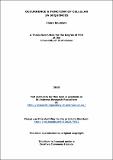Files in this item
Occurrence & function of cellular 2A sequences
Item metadata
| dc.contributor.advisor | Ryan, Martin Denis | |
| dc.contributor.author | Roulston, Claire | |
| dc.coverage.spatial | 218 | en_US |
| dc.date.accessioned | 2015-07-28T14:55:19Z | |
| dc.date.available | 2015-07-28T14:55:19Z | |
| dc.date.issued | 2015-06-24 | |
| dc.identifier | uk.bl.ethos.658892 | |
| dc.identifier | uk.bl.ethos.658892 | |
| dc.identifier.uri | https://hdl.handle.net/10023/7062 | |
| dc.description.abstract | This thesis describes experiments investigating the translational recoding activities and the novel dual signalling properties of eukaryotic ribosome skipping 2A sequences. Over twenty years ago, the 19 amino acid 2A region of a Picornavirus; namely, Foot-and-Mouth Disease Virus (FMDV) polypeptide was shown to possess apparent “self-cleaving” abilities, cutting at its own C-terminus during translation (Ryan et al., 1991). Active FMDV 2A-like sequences were subsequently found in a number of related viruses (Luke et al., 2008), with several now utilised as essential biotechnology multi-gene transfer tools (Luke et al., 2010b). Then, in 2006, eukaryotic 2A-like sequences were identified from trypanosome non-LTR sequences. These were found to be functional in vitro (Heras et al., 2006). I have been able to identify over 400 putative eukaryotic 2A-like sequences through searching the freely available online proteomic and genomic databases. Data is presented to show that these 2As were encoded in frame with non-LTRs, or metabolic, or immune function genes, from a wide range of eukaryotic organisms; but I could not discern any obvious phylogenetic distribution for 2A. I have discovered that the majority of eukaryotic 2A sequences tested can mediate ribosome skipping in vitro. Modelling in silico indicated that active 2A-like sequences possessed the propensity to form a central alpha-helical region, whereas the models suggested that inactive 2A-like sequences would be essentially unstructured. I also report that some of these eukaryotic 2A peptides constitute a novel form of dual protein targeting as they play a dual role as exocytic pathway signal peptides mediating extracellular protein trafficking. I have shown that this protein trafficking ability is evolutionarily conserved, with an echinoderm sequence able to direct protein targeting in both plant and mammalian cells. I therefore propose that these novel eukaryotic 2A sequences could potentially become extremely valuable in biotechnological engineering. | en_US |
| dc.language.iso | en | en_US |
| dc.publisher | University of St Andrews | |
| dc.rights | Creative Commons Attribution-NonCommercial-NoDerivatives 4.0 International | |
| dc.rights.uri | http://creativecommons.org/licenses/by-nc-nd/4.0/ | |
| dc.subject | 2A peptides | en_US |
| dc.subject | Ribosome skipping | en_US |
| dc.subject | Translational recoding | en_US |
| dc.subject | Non-viral 2As | en_US |
| dc.subject | Protein targeting | en_US |
| dc.subject | Signal peptides | en_US |
| dc.subject.lcc | QH450.5R7 | |
| dc.subject.lcsh | Peptides | en_US |
| dc.subject.lcsh | Genetic translation | en_US |
| dc.subject.lcsh | Ribosomes | en_US |
| dc.subject.lcsh | Picornaviruses | en_US |
| dc.title | Occurrence & function of cellular 2A sequences | en_US |
| dc.title.alternative | Occurrence and function of cellular 2A sequences | en_US |
| dc.type | Thesis | en_US |
| dc.type.qualificationlevel | Doctoral | en_US |
| dc.type.qualificationname | PhD Doctor of Philosophy | en_US |
| dc.publisher.institution | The University of St Andrews | en_US |
This item appears in the following Collection(s)
Except where otherwise noted within the work, this item's licence for re-use is described as Creative Commons Attribution-NonCommercial-NoDerivatives 4.0 International
Items in the St Andrews Research Repository are protected by copyright, with all rights reserved, unless otherwise indicated.


